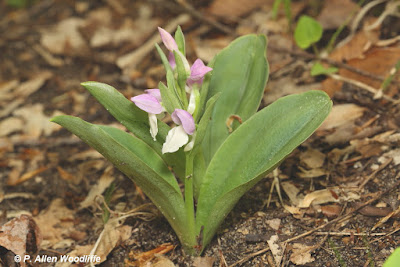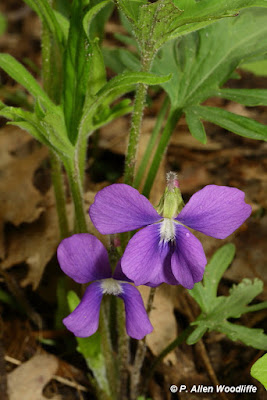What follows are just a few of the wildflowers that have caught my eye.
Many readers will likely recognize most of the ones I include on this post. Probably the most recognizable one is the White Trillium, the provincial flower of Ontario.
Less recognizable is the Red Trillium, at least in the form shown next. Trilliums are known to have peculiarities, and sometimes some real unusual ones appear. Normal trilliums have three petals. For some reason this plant got double! Actually this photo was taken a couple of years ago. It didn't show up in 2017, and when I went to check on it in 2018 it was already well past its best.
Wild Columbine is always a treat to see. Hummingbirds are on the lookout for it as well, as they hover beneath the flower and stick their long bills and tongues up the flower tube to get to the nectar in the little bulb at the tip. This next photo shows a typical Wild Columbine.
As in the case of the Red Trillium, there can be some unusual forms of Wild Columbine. They can occasionally be a pale reddish orange, but very rarely do you see a pale yellow, almost white, version. In fact I have only seen this on two occasions at Rondeau. I came across this plant a couple of years ago, and so far it has reappeared in successive years. I'm not sure what the hummingbirds think about this colour form. White wine vs red wine???
Wild orchids are always a treat to find. This next plant is Showy Orchis (Galearis spectabilis). It is a small orchid and is generally very uncommon in rich deciduous hardwoods forests.
Wild Geranium is widespread.
Sweet Cicely is common in woodlands. Its flowers are small, and once they finish flowering you hardly notice them, until they go to seed. Then you find out the hard way, if you go walking through a stand of them, that those seeds are hard, pointed and can be somewhat painful. They have a tendency to get stuck in pants, socks and whatever they can latch on to, with their pointed ends jabbing your skin underneath.
Violets are numerous, and one of the most common ones is Downy Yellow Violet.
Much less common, and restricted to sandy open woods is Wood Violet, shown next. The flowers don't look all that different from other bluish-purple violets, but the leaves are distinctive.
Another uncommon plant is this next one: American Gromwell.
It was on the Rondeau plant checklist, but it had not been seen since the early 1960s. It had been ranked as 'historic' for Chatham-Kent. Last year I came across a single clump, and included it in a blog post about a year ago. When I was in its locale this year, I did a more careful but quick check and noted there were about 10 clusters. Another person alerted me to the location of another clump and when I went and found it and did a more thorough check of the overall area, I came up with 17 clusters. Undoubtedly there are others, too.
From even a short distance away, it blends in with the lush vegetation it grows amongst, so it isn't surprising that it can be missed.
If you looked at the individual flowers and thought they looked like those of a puccoon that you might find on the sandy beach dunes, good for you! The flowers are indeed similar, but yellow instead of orangey-yellow. And they are of the same genus: Lithospermum.
The heavy overcast days were great for finding and photographing wildflowers. It was also ideal for forest photography.
At least a few of these will continue to bloom well into June.
























it is always so wonderful to see life and colour returning through the wild flowers.
ReplyDeleteIt is indeed. One has to be quick to see them,however, as they flower early and quickly before the leaves of the forest trees shade them.
Delete